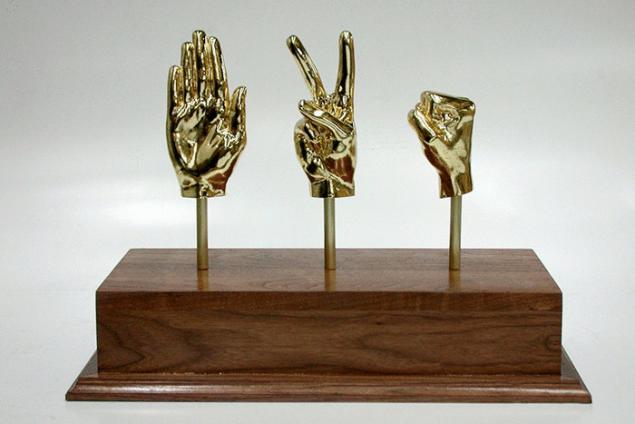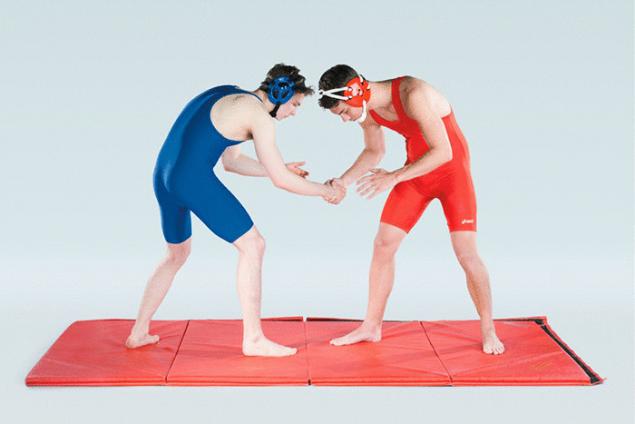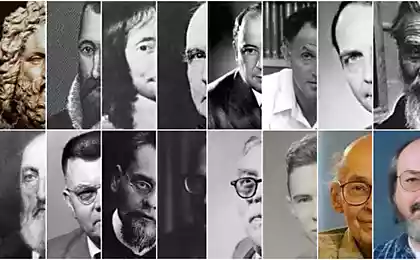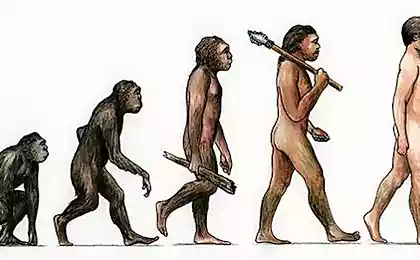681
What is our life: why do economists study game theory
Thirty three million twenty two thousand three hundred fifty six
© Joao Figueiredo
Emerged in the forties of the XX century mathematical game theory is often applied in Economics. But with the help of the concept of games to simulate the behavior of people in society? Why economists study what angle often evaluate players and how to win at "Rock, scissors, paper" in his lecture said a senior teacher of the Department of microeconomic analysis Danil fedorovykh, HSE
John Nash and the blonde at the bar
A game is any situation in which the agent's profit depends not only on its own actions but also from the behavior of the other participants. If you put them in the box solitaire, from the point of view of the economist and game theory, this is not a game. It implies the necessary presence of conflict of interests.
In the movie "a beautiful mind" about John Nash, Nobel prize winner for Economics, there is a scene with the blonde at the bar. It shows the idea for which scholar and received the award, is the idea of Nash equilibria, which he called management dynamics.
Game — any situation in which the winnings of agents independent of each other.
So, from the point of view of the theory, players in this situation are only men, that is, those who make the decision. Their preference is simple: the blonde better than brunette, but brunette is better than nothing. You can act in two ways: go to the blonde or a brunette. The game consists of a single move, the decisions are made simultaneously (that is, you cannot see where the other went, and after the walk itself). If some girl rejects a man, the game ends: it is impossible to return to it or choose another.
Strategy a description of the actions of the player in all possible situations.
What is the likely ending of this situation? That is, what is its stable configuration, all of which will see you made the best choice? First, notice how Nash, if all goes to the blonde, nothing good is not over. So the scientist assumes that all need to go for brunettes. But then, if you know that all goes to the brunette, he should go for the blonde, because she's better.
The outcome is a combination of the selected strategies.
This is the real equilibrium outcome in which one goes to the blonde and other brunette. It may seem that it is unfair. But in a situation of equilibrium, no one can regret his choice: those who go for brunettes, you know that they are blonde still nothing received. Thus, the Nash equilibrium is a configuration in which no individually do not want to change all of the selected strategy. That is, on reflection at the end of the game, each participant understands that, even knowing, as like others, he would have done the same thing. You can call it an outcome, where each party optimally responds to the actions of others.
"Rock, scissors, paper"

Consider other games on the subject of balance. For example, in "Stone, scissors, paper" no Nash equilibria: in all of its possible outcomes there is no option in which both parties would be happy with my choice. However, there is the world Cup and World Rock Paper Scissors Society, collecting game statistics. Obviously, you can increase your chances of winning if you know something about the normal behavior of people in this game.
Pure strategy game is a strategy in which a person always playing the same, choosing the same moves.
According to the World RPS Society, the stone is the most frequently selected course (37.8 per cent). Paper is put to 32.6%, scissors is 29.6%. Now you know that you need to choose the paper. However, if you're playing someone who knows it, you will not need to choose paper, because you are expected to be the same. There is a famous case: in 2005, two auction houses Sotheby's and Christie's decided who will get very large lot — collection of Picasso and van Gogh with a starting price of $ 20 million. The owner asked them to play "Rock, scissors, paper", and the representatives of the houses sent him their own versions of e-mail. Sotheby's, as they later told, without thinking, chose the paper. Won Christie's. Taking the decision, they turned to the expert — 11-year-old daughter of Director impressionism. She said, "the Stone seems very strong, so most people choose it. But if we're not completely stupid rookie, he's a stone throw away, will expect we do it, and he will throw out the paper. But we will think to move forward, and throw the scissors."
Thus, you can think one move ahead, but it will not necessarily lead you to victory, because you may not know about the competence of your opponent. So sometimes instead of pure strategies to choose correctly mixed, that is, to make decisions by accident. So, in "Stone, scissors, paper" balance, which we never found, is in mixed strategies: choose each of the three move with a probability of one third. If you choose a stone more often, the opponent will adjust his choice. Knowing this, you will adjust, and balance will come. But none of you will change the behavior, if everyone is just going to choose stone, scissors or paper with equal probability. All because in mixed strategies of the previous actions it is impossible to predict your next move.
Mixed strategies and activities

More serious examples of mixed strategies are many. For example, where to serve in tennis or hit/accept a penalty in football. If you don't know anything about your opponent or just keep playing against different the best strategy is to do more or less by accident. Professor London school of Economics, Ignacio Palacios-Huerta in 2003, published in the American Economic Review the work, the essence of which was to search for Nash equilibria in mixed strategies. The subject of the study, Palacios-Huerta chose football and therefore was viewed more than 1,400 penalty strokes. Of course, in sports, everything is arranged smarter than the "Stone, scissors, paper": there is considered a strong athlete's foot, hitting at different angles when hitting with all his strength, and the like. The Nash equilibrium here is the calculation, that is, for example, determining the corners of the gate, in which you have to beat to win more likely, knowing their strengths and weaknesses. Statistics for each player and its equilibrium in mixed strategies, showed that the players do about the way economists predict. It is hardly necessary to say that the people who evaluate reading textbooks on the theory of games and doing fairly complicated math. Most likely, there are different ways to learn how to behave optimally: you can be a brilliant player to feel, what to do, as well as the economist, and look for an equilibrium in mixed strategies.
In 2008, Professor Ignacio Palacios-Huerta met with Abraham Grant, trainer of "Chelsea", which was playing in the Champions League final in Moscow. The scientist wrote a note to the coach with the recommendations on penalties, which deals with the behavior of the goalkeeper — Edwin van der SAR from the "Manchester United". For example, according to statistics, it is almost always repulsed the attacks on the middle level and more rushed in their natural penalty takers side. As we have determined above, better still to randomize their behavior taking into account the knowledge about the opponent. When the score on penalties was already 6:5, Nicolas Anelka, striker, Chelsea should have scored. Showing before striking into the right corner, van der SAR if asked Anelka, if he was going to beat there.
The point is that all previous attacks "Chelsea" was struck exactly in the right angle to penetrate. We don't know exactly why, maybe because of the advice of an economist to beat in an unnatural way for them, because according to statistics less than ready for this van der SAR. Most of the Chelsea players were right-handed: hitting in an unnatural right angle, all of them except Terry scored. Apparently, the strategy was that Anelka struck there too. But van der SAR seems to have understood it. It was a stroke of genius: showed in the left corner say "there going to beat?", from what Anelka probably horrified, because it did. At the last moment he decided to act differently, struck in its natural direction, and needed van der SAR, who took the blow and ensured a United victory. This situation teaches a random choice, as otherwise your decision could be calculated, and you will lose.
"Prisoner's dilemma"
Probably the most well-known game, which starts University courses on game theory is "prisoner's Dilemma". According to legend, the two suspects in a serious crime are caught and locked in separate cells. There is evidence that they kept the weapons, and it allows you to plant them for a small period of time. However, the evidence that they have committed this terrible crime, no. Each investigator talks about the conditions of the game. If both criminals confess, both will sit for three years. If one confesses and the accomplice will remain silent, confessed will be released immediately and the second one will go to jail for five years. Conversely, if the first did not confess, and the second pass, the first sit for five years, and the second will be released immediately. If no one confesses, both will sit for a year for possession of weapons.The Nash equilibrium here is the first combination, when both suspects are not silent and they sit for three years. The arguments of each are as follows: "if I speak, I sit for three years, if silent — for five years. If the second will be silent, I should also say, not to get better than to sit for a year." It is the dominant strategy: to say profitable, regardless of what others are doing. But it has one problem — the existence of a better option, because you can get three years worse than sitting down for a year (if we consider the history only from the point of view of participants and do not consider questions of morality). But take the year it is impossible, because, as we saw above, silence both criminals unprofitable.
A Pareto improvement
There is a famous metaphor about the invisible hand of the market, owned by Adam Smith. He said that if the butcher will be for himself to try to earn money, this will be better for everyone: it will make a delicious meat that will buy the Baker with the money from the sale of the bullock, which he, in turn, also will need to make delicious that they sold. But it turns out that this invisible hand doesn't always work, and situations where each acts for himself, and all bad, very much.
So sometimes economists and experts in game theory do not think about the optimal behavior of each player, that is not the Nash equilibrium, and the outcome, which will better all of society (in the "Dilemma" society consists of two criminals). From this point of view, the outcome is efficient when there is no Pareto improvement, that is impossible to make someone better without making others worse. If people just change goods and services is Pareto-improving: they do it voluntarily and it is unlikely that someone this bad. But sometimes, if you just give people to interact with and even not to interfere with what they come, will not be Pareto optimal. This happens in the prisoner's Dilemma. In it, if we give each act as it suits them, it turns out that all of this is bad. Would all be better off if everyone did not act optimally for themselves, that is silent.
Community tragedy
"Prisoner's dilemma" is a stylized toy story. It is unlikely that you expect to be in a similar situation, but similar effects are everywhere around us. Consider the "Dilemma" with a large number of players, it is sometimes called the tragedy of the community. For example, road traffic, and I decide how to go to work: by car or by bus. It's doing the rest. If I drive the car and all decide to do the same, there's traffic, but we'll get there in comfort. If I take the bus, the tube will still, but to go I'll be uncomfortable and not particularly faster, so this outcome is even worse. If, on average ride the bus, I do the same, quickly reach without traffic jams. But if under these conditions to go on the car, I also drive fast, but also with comfort. Thus, the presence of the tube does not depend on my actions. The Nash equilibrium here — in a situation when all chosen to go by car. That would not do the rest, I better take the car because there is a tube or not is unknown, but I in any case will reach with comfort. It is the dominant strategy, so in the end all go by car and we have what we have. The state's task — to make the trip by bus the best option at least for some, so be paid the entrances to the centre, Parking and so on.Another classic story — the rational ignorance of the voter. Imagine that you don't know the outcome in advance. You may study all the candidates, to listen to the debate and after the vote for the best. The second strategy is to come to the site and vote haphazardly, or for someone that was often shown on TV. What behavior is optimal if my voice never depends on who wins (and in a 140 million country one vote will never decide)? Of course I want to be in the country was a good President, but I know that no one else will study the candidates carefully. So don't waste time on it is a dominant strategy.
When you are invited to come on Saturday, no one separately will not be affected, will be the yard clean or not: if I get one, I will not be able to remove all, or, if you will all, I will not, because all I will be gone. Another example is the transport of goods in China, which I learned in a wonderful book by Stephen Landsberg "Economist on the couch". 100-150 years ago, China was a common method of transporting goods: everything went in a large body that was carrying seven people. Customers pay, if the goods were delivered on time. Imagine that you are one of those six. You can endeavor and pull hard, and if all will do so, the goods will reach in time. If one will not do, all the same will reach on time. Everyone thinks: "If everyone else is pulling as it should, why do it to me, and if everyone else is not pulling with all his strength, there's nothing I can change." In the end, with the delivery time it was very bad, and the movers themselves found a way out: they began to recruit the seventh and to pay him the money that he lashed the lazy whip. The very existence of such a person forced everyone to work hard, because otherwise all fall into a bad equilibrium from which no one in particular with the benefit of not to go.
The same example can be observed in nature. A tree growing in the garden, different from what grows in the forest, with its crown. In the first case, it surrounds the barrel, the second is only at the top. In the forest it is a Nash equilibrium. If all the trees agreed and raised the same, they would be equally distributed number of photons, and all would be better. But to no one in particular to do so is unprofitable. Therefore every tree wants to grow a little higher than others.
Сommitment device
In many situations one of the participants may need a tool that will convince others that he is not bluffing. It's called a commitment device. For example, the law in some countries forbids to pay a ransom to the kidnappers to reduce the motivation of criminals. However, this legislation often does not work. If your family member is captured, and you have the opportunity to rescue him, bypassing the law, you do. Imagine the situation that the law can be circumvented, but the relatives were poor and the ransom they pay nothing. The offender in this situation in two ways: to release or kill the victim. To kill he doesn't like, but he doesn't like. Released the victim in turn, may either give evidence that the thief was punished, or to remain silent. The best outcome for the offender to release the victim who did not surrender. The victim wants to be released and to testify.
The balance here is that the terrorist doesn't want to be caught, and so the victim dies. But it is not a Pareto equilibrium, because there is a variant in which all the better — victim is on the loose silent. But for this it is necessary to do so to be silent it was beneficial. Somewhere I read an option when it can ask for terrorist to arrange an erotic photo session. If the offender is jailed, his accomplices will post pictures on the Internet. Now, if the thief remains at large is a bad thing, but the photos in the public domain — even worse, so there is a balance. For the victim it is a way to stay alive.
Other examples: since we are talking about the economy, consider the economic example. In the model of Bertrand two stores sell the same product buying it from the manufacturer at the same price. If the prices in the shops are the same, about the same and their profit, because then the buyers choose a store by accident. The only Nash equilibrium here is to sell the product at cost. But the shops want to make money. So if one put a price of 10 rubles, the second reduces it by a penny, increasing its revenues by half, as it will leave all buyers. Therefore, market participants profitable to reduce prices, thus balancing the profits between themselves.Consider the examples of choice between two possible equilibria. Imagine that Peter and Mary are going to meet each other on a narrow road. The road is so narrow that they both need to pull over. If they decide to turn left or right they just disperse. If one will turn to the right, and another left, or Vice versa, there is an accident. How to choose where to go? To help to seek equilibrium in such games, there are, for example, the rules of the road. In Russia, everyone should turn right.
Chiken in the fun when two people go at great speed towards each other, also there are two equilibrium. If both curtail on a roadside, a situation arises called Chiken out if both are not turned, killed in a terrible accident. If I know my opponent is driving straight, it is beneficial for me to move out to survive. If I know my opponent will move, it is beneficial for me to go straight to after to $ 100. It is difficult to predict what will happen in reality, however, each player has its own method to win. Imagine that I fixed the steering wheel so that it cannot be turned, and showed it to his opponent. Knowing that I have no choice, the opponent will bounce.
Sometimes it is very difficult to move from one equilibrium to another, even if it means benefit for all. The QWERTY layout was created to slow down the printing speed. Because if everyone was typing too fast, the head of a typewriter, which hit the paper to cling to each other. So Christopher Scholes posted often standing next to the letters on the most far distance. If you go into the keyboard settings on your computer, you can choose the Dvorak layout, and print much faster, because now there is no problem of analog printing machines. Dvorak is expected that the world will move on his keyboard, but we are still living with QWERTY. Of course, if we switched to the Dvorak layout, the future generation would be grateful to us. We all would put effort and retrained, the result would be equilibrium, in which all typing quickly. Now we are on balance bad. But no one pays to be the only one who retrain, because any computer other than your own, work will be uncomfortable.
Source: theoryandpractice.ru
© Joao Figueiredo
Emerged in the forties of the XX century mathematical game theory is often applied in Economics. But with the help of the concept of games to simulate the behavior of people in society? Why economists study what angle often evaluate players and how to win at "Rock, scissors, paper" in his lecture said a senior teacher of the Department of microeconomic analysis Danil fedorovykh, HSE
John Nash and the blonde at the bar
A game is any situation in which the agent's profit depends not only on its own actions but also from the behavior of the other participants. If you put them in the box solitaire, from the point of view of the economist and game theory, this is not a game. It implies the necessary presence of conflict of interests.
In the movie "a beautiful mind" about John Nash, Nobel prize winner for Economics, there is a scene with the blonde at the bar. It shows the idea for which scholar and received the award, is the idea of Nash equilibria, which he called management dynamics.
Game — any situation in which the winnings of agents independent of each other.
So, from the point of view of the theory, players in this situation are only men, that is, those who make the decision. Their preference is simple: the blonde better than brunette, but brunette is better than nothing. You can act in two ways: go to the blonde or a brunette. The game consists of a single move, the decisions are made simultaneously (that is, you cannot see where the other went, and after the walk itself). If some girl rejects a man, the game ends: it is impossible to return to it or choose another.
Strategy a description of the actions of the player in all possible situations.
What is the likely ending of this situation? That is, what is its stable configuration, all of which will see you made the best choice? First, notice how Nash, if all goes to the blonde, nothing good is not over. So the scientist assumes that all need to go for brunettes. But then, if you know that all goes to the brunette, he should go for the blonde, because she's better.
The outcome is a combination of the selected strategies.
This is the real equilibrium outcome in which one goes to the blonde and other brunette. It may seem that it is unfair. But in a situation of equilibrium, no one can regret his choice: those who go for brunettes, you know that they are blonde still nothing received. Thus, the Nash equilibrium is a configuration in which no individually do not want to change all of the selected strategy. That is, on reflection at the end of the game, each participant understands that, even knowing, as like others, he would have done the same thing. You can call it an outcome, where each party optimally responds to the actions of others.
"Rock, scissors, paper"

Consider other games on the subject of balance. For example, in "Stone, scissors, paper" no Nash equilibria: in all of its possible outcomes there is no option in which both parties would be happy with my choice. However, there is the world Cup and World Rock Paper Scissors Society, collecting game statistics. Obviously, you can increase your chances of winning if you know something about the normal behavior of people in this game.
Pure strategy game is a strategy in which a person always playing the same, choosing the same moves.
According to the World RPS Society, the stone is the most frequently selected course (37.8 per cent). Paper is put to 32.6%, scissors is 29.6%. Now you know that you need to choose the paper. However, if you're playing someone who knows it, you will not need to choose paper, because you are expected to be the same. There is a famous case: in 2005, two auction houses Sotheby's and Christie's decided who will get very large lot — collection of Picasso and van Gogh with a starting price of $ 20 million. The owner asked them to play "Rock, scissors, paper", and the representatives of the houses sent him their own versions of e-mail. Sotheby's, as they later told, without thinking, chose the paper. Won Christie's. Taking the decision, they turned to the expert — 11-year-old daughter of Director impressionism. She said, "the Stone seems very strong, so most people choose it. But if we're not completely stupid rookie, he's a stone throw away, will expect we do it, and he will throw out the paper. But we will think to move forward, and throw the scissors."
Thus, you can think one move ahead, but it will not necessarily lead you to victory, because you may not know about the competence of your opponent. So sometimes instead of pure strategies to choose correctly mixed, that is, to make decisions by accident. So, in "Stone, scissors, paper" balance, which we never found, is in mixed strategies: choose each of the three move with a probability of one third. If you choose a stone more often, the opponent will adjust his choice. Knowing this, you will adjust, and balance will come. But none of you will change the behavior, if everyone is just going to choose stone, scissors or paper with equal probability. All because in mixed strategies of the previous actions it is impossible to predict your next move.
Mixed strategies and activities

More serious examples of mixed strategies are many. For example, where to serve in tennis or hit/accept a penalty in football. If you don't know anything about your opponent or just keep playing against different the best strategy is to do more or less by accident. Professor London school of Economics, Ignacio Palacios-Huerta in 2003, published in the American Economic Review the work, the essence of which was to search for Nash equilibria in mixed strategies. The subject of the study, Palacios-Huerta chose football and therefore was viewed more than 1,400 penalty strokes. Of course, in sports, everything is arranged smarter than the "Stone, scissors, paper": there is considered a strong athlete's foot, hitting at different angles when hitting with all his strength, and the like. The Nash equilibrium here is the calculation, that is, for example, determining the corners of the gate, in which you have to beat to win more likely, knowing their strengths and weaknesses. Statistics for each player and its equilibrium in mixed strategies, showed that the players do about the way economists predict. It is hardly necessary to say that the people who evaluate reading textbooks on the theory of games and doing fairly complicated math. Most likely, there are different ways to learn how to behave optimally: you can be a brilliant player to feel, what to do, as well as the economist, and look for an equilibrium in mixed strategies.
In 2008, Professor Ignacio Palacios-Huerta met with Abraham Grant, trainer of "Chelsea", which was playing in the Champions League final in Moscow. The scientist wrote a note to the coach with the recommendations on penalties, which deals with the behavior of the goalkeeper — Edwin van der SAR from the "Manchester United". For example, according to statistics, it is almost always repulsed the attacks on the middle level and more rushed in their natural penalty takers side. As we have determined above, better still to randomize their behavior taking into account the knowledge about the opponent. When the score on penalties was already 6:5, Nicolas Anelka, striker, Chelsea should have scored. Showing before striking into the right corner, van der SAR if asked Anelka, if he was going to beat there.
The point is that all previous attacks "Chelsea" was struck exactly in the right angle to penetrate. We don't know exactly why, maybe because of the advice of an economist to beat in an unnatural way for them, because according to statistics less than ready for this van der SAR. Most of the Chelsea players were right-handed: hitting in an unnatural right angle, all of them except Terry scored. Apparently, the strategy was that Anelka struck there too. But van der SAR seems to have understood it. It was a stroke of genius: showed in the left corner say "there going to beat?", from what Anelka probably horrified, because it did. At the last moment he decided to act differently, struck in its natural direction, and needed van der SAR, who took the blow and ensured a United victory. This situation teaches a random choice, as otherwise your decision could be calculated, and you will lose.
"Prisoner's dilemma"
Probably the most well-known game, which starts University courses on game theory is "prisoner's Dilemma". According to legend, the two suspects in a serious crime are caught and locked in separate cells. There is evidence that they kept the weapons, and it allows you to plant them for a small period of time. However, the evidence that they have committed this terrible crime, no. Each investigator talks about the conditions of the game. If both criminals confess, both will sit for three years. If one confesses and the accomplice will remain silent, confessed will be released immediately and the second one will go to jail for five years. Conversely, if the first did not confess, and the second pass, the first sit for five years, and the second will be released immediately. If no one confesses, both will sit for a year for possession of weapons.The Nash equilibrium here is the first combination, when both suspects are not silent and they sit for three years. The arguments of each are as follows: "if I speak, I sit for three years, if silent — for five years. If the second will be silent, I should also say, not to get better than to sit for a year." It is the dominant strategy: to say profitable, regardless of what others are doing. But it has one problem — the existence of a better option, because you can get three years worse than sitting down for a year (if we consider the history only from the point of view of participants and do not consider questions of morality). But take the year it is impossible, because, as we saw above, silence both criminals unprofitable.
A Pareto improvement
There is a famous metaphor about the invisible hand of the market, owned by Adam Smith. He said that if the butcher will be for himself to try to earn money, this will be better for everyone: it will make a delicious meat that will buy the Baker with the money from the sale of the bullock, which he, in turn, also will need to make delicious that they sold. But it turns out that this invisible hand doesn't always work, and situations where each acts for himself, and all bad, very much.
So sometimes economists and experts in game theory do not think about the optimal behavior of each player, that is not the Nash equilibrium, and the outcome, which will better all of society (in the "Dilemma" society consists of two criminals). From this point of view, the outcome is efficient when there is no Pareto improvement, that is impossible to make someone better without making others worse. If people just change goods and services is Pareto-improving: they do it voluntarily and it is unlikely that someone this bad. But sometimes, if you just give people to interact with and even not to interfere with what they come, will not be Pareto optimal. This happens in the prisoner's Dilemma. In it, if we give each act as it suits them, it turns out that all of this is bad. Would all be better off if everyone did not act optimally for themselves, that is silent.
Community tragedy
"Prisoner's dilemma" is a stylized toy story. It is unlikely that you expect to be in a similar situation, but similar effects are everywhere around us. Consider the "Dilemma" with a large number of players, it is sometimes called the tragedy of the community. For example, road traffic, and I decide how to go to work: by car or by bus. It's doing the rest. If I drive the car and all decide to do the same, there's traffic, but we'll get there in comfort. If I take the bus, the tube will still, but to go I'll be uncomfortable and not particularly faster, so this outcome is even worse. If, on average ride the bus, I do the same, quickly reach without traffic jams. But if under these conditions to go on the car, I also drive fast, but also with comfort. Thus, the presence of the tube does not depend on my actions. The Nash equilibrium here — in a situation when all chosen to go by car. That would not do the rest, I better take the car because there is a tube or not is unknown, but I in any case will reach with comfort. It is the dominant strategy, so in the end all go by car and we have what we have. The state's task — to make the trip by bus the best option at least for some, so be paid the entrances to the centre, Parking and so on.Another classic story — the rational ignorance of the voter. Imagine that you don't know the outcome in advance. You may study all the candidates, to listen to the debate and after the vote for the best. The second strategy is to come to the site and vote haphazardly, or for someone that was often shown on TV. What behavior is optimal if my voice never depends on who wins (and in a 140 million country one vote will never decide)? Of course I want to be in the country was a good President, but I know that no one else will study the candidates carefully. So don't waste time on it is a dominant strategy.
When you are invited to come on Saturday, no one separately will not be affected, will be the yard clean or not: if I get one, I will not be able to remove all, or, if you will all, I will not, because all I will be gone. Another example is the transport of goods in China, which I learned in a wonderful book by Stephen Landsberg "Economist on the couch". 100-150 years ago, China was a common method of transporting goods: everything went in a large body that was carrying seven people. Customers pay, if the goods were delivered on time. Imagine that you are one of those six. You can endeavor and pull hard, and if all will do so, the goods will reach in time. If one will not do, all the same will reach on time. Everyone thinks: "If everyone else is pulling as it should, why do it to me, and if everyone else is not pulling with all his strength, there's nothing I can change." In the end, with the delivery time it was very bad, and the movers themselves found a way out: they began to recruit the seventh and to pay him the money that he lashed the lazy whip. The very existence of such a person forced everyone to work hard, because otherwise all fall into a bad equilibrium from which no one in particular with the benefit of not to go.
The same example can be observed in nature. A tree growing in the garden, different from what grows in the forest, with its crown. In the first case, it surrounds the barrel, the second is only at the top. In the forest it is a Nash equilibrium. If all the trees agreed and raised the same, they would be equally distributed number of photons, and all would be better. But to no one in particular to do so is unprofitable. Therefore every tree wants to grow a little higher than others.
Сommitment device
In many situations one of the participants may need a tool that will convince others that he is not bluffing. It's called a commitment device. For example, the law in some countries forbids to pay a ransom to the kidnappers to reduce the motivation of criminals. However, this legislation often does not work. If your family member is captured, and you have the opportunity to rescue him, bypassing the law, you do. Imagine the situation that the law can be circumvented, but the relatives were poor and the ransom they pay nothing. The offender in this situation in two ways: to release or kill the victim. To kill he doesn't like, but he doesn't like. Released the victim in turn, may either give evidence that the thief was punished, or to remain silent. The best outcome for the offender to release the victim who did not surrender. The victim wants to be released and to testify.
The balance here is that the terrorist doesn't want to be caught, and so the victim dies. But it is not a Pareto equilibrium, because there is a variant in which all the better — victim is on the loose silent. But for this it is necessary to do so to be silent it was beneficial. Somewhere I read an option when it can ask for terrorist to arrange an erotic photo session. If the offender is jailed, his accomplices will post pictures on the Internet. Now, if the thief remains at large is a bad thing, but the photos in the public domain — even worse, so there is a balance. For the victim it is a way to stay alive.
Other examples: since we are talking about the economy, consider the economic example. In the model of Bertrand two stores sell the same product buying it from the manufacturer at the same price. If the prices in the shops are the same, about the same and their profit, because then the buyers choose a store by accident. The only Nash equilibrium here is to sell the product at cost. But the shops want to make money. So if one put a price of 10 rubles, the second reduces it by a penny, increasing its revenues by half, as it will leave all buyers. Therefore, market participants profitable to reduce prices, thus balancing the profits between themselves.Consider the examples of choice between two possible equilibria. Imagine that Peter and Mary are going to meet each other on a narrow road. The road is so narrow that they both need to pull over. If they decide to turn left or right they just disperse. If one will turn to the right, and another left, or Vice versa, there is an accident. How to choose where to go? To help to seek equilibrium in such games, there are, for example, the rules of the road. In Russia, everyone should turn right.
Chiken in the fun when two people go at great speed towards each other, also there are two equilibrium. If both curtail on a roadside, a situation arises called Chiken out if both are not turned, killed in a terrible accident. If I know my opponent is driving straight, it is beneficial for me to move out to survive. If I know my opponent will move, it is beneficial for me to go straight to after to $ 100. It is difficult to predict what will happen in reality, however, each player has its own method to win. Imagine that I fixed the steering wheel so that it cannot be turned, and showed it to his opponent. Knowing that I have no choice, the opponent will bounce.
Sometimes it is very difficult to move from one equilibrium to another, even if it means benefit for all. The QWERTY layout was created to slow down the printing speed. Because if everyone was typing too fast, the head of a typewriter, which hit the paper to cling to each other. So Christopher Scholes posted often standing next to the letters on the most far distance. If you go into the keyboard settings on your computer, you can choose the Dvorak layout, and print much faster, because now there is no problem of analog printing machines. Dvorak is expected that the world will move on his keyboard, but we are still living with QWERTY. Of course, if we switched to the Dvorak layout, the future generation would be grateful to us. We all would put effort and retrained, the result would be equilibrium, in which all typing quickly. Now we are on balance bad. But no one pays to be the only one who retrain, because any computer other than your own, work will be uncomfortable.
Source: theoryandpractice.ru
Useful sweets — carrot cakes stuffed with dried fruit
New super-efficient and affordable solar panels from Rayton Solar























